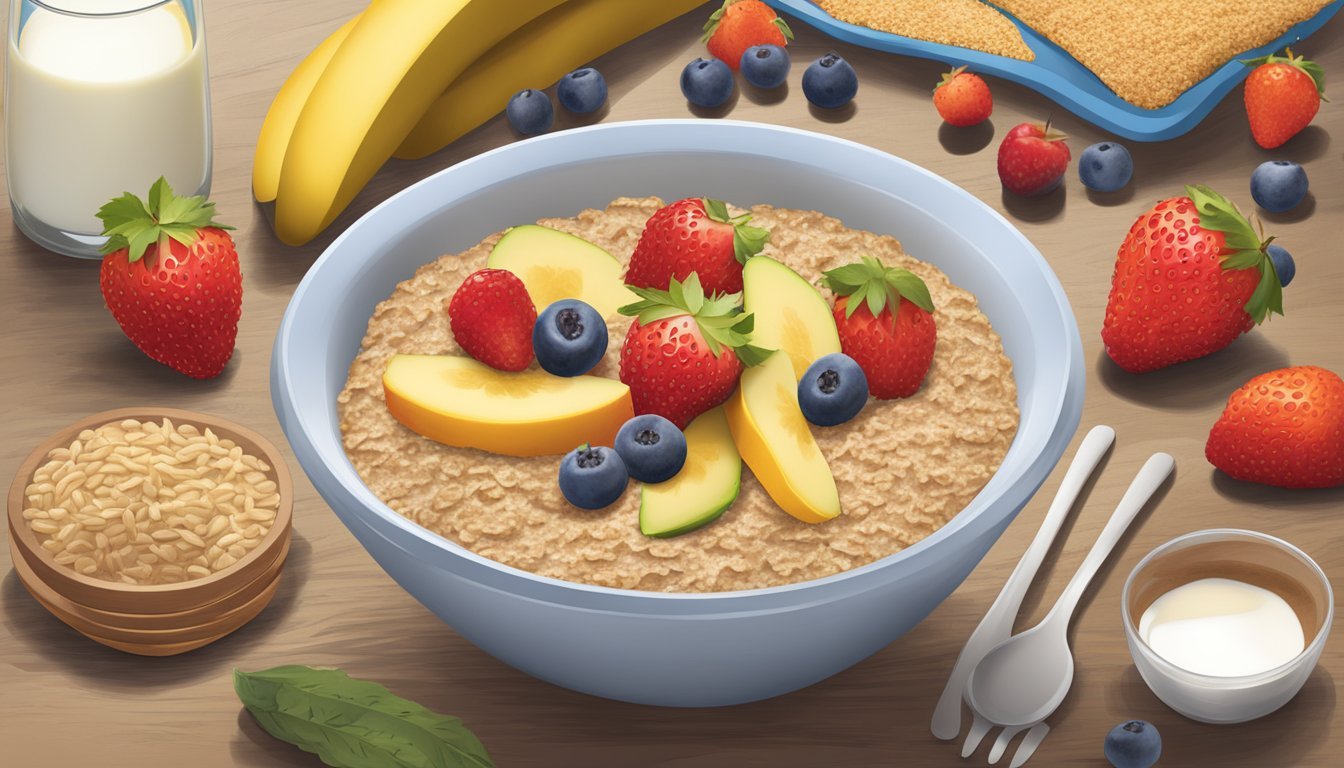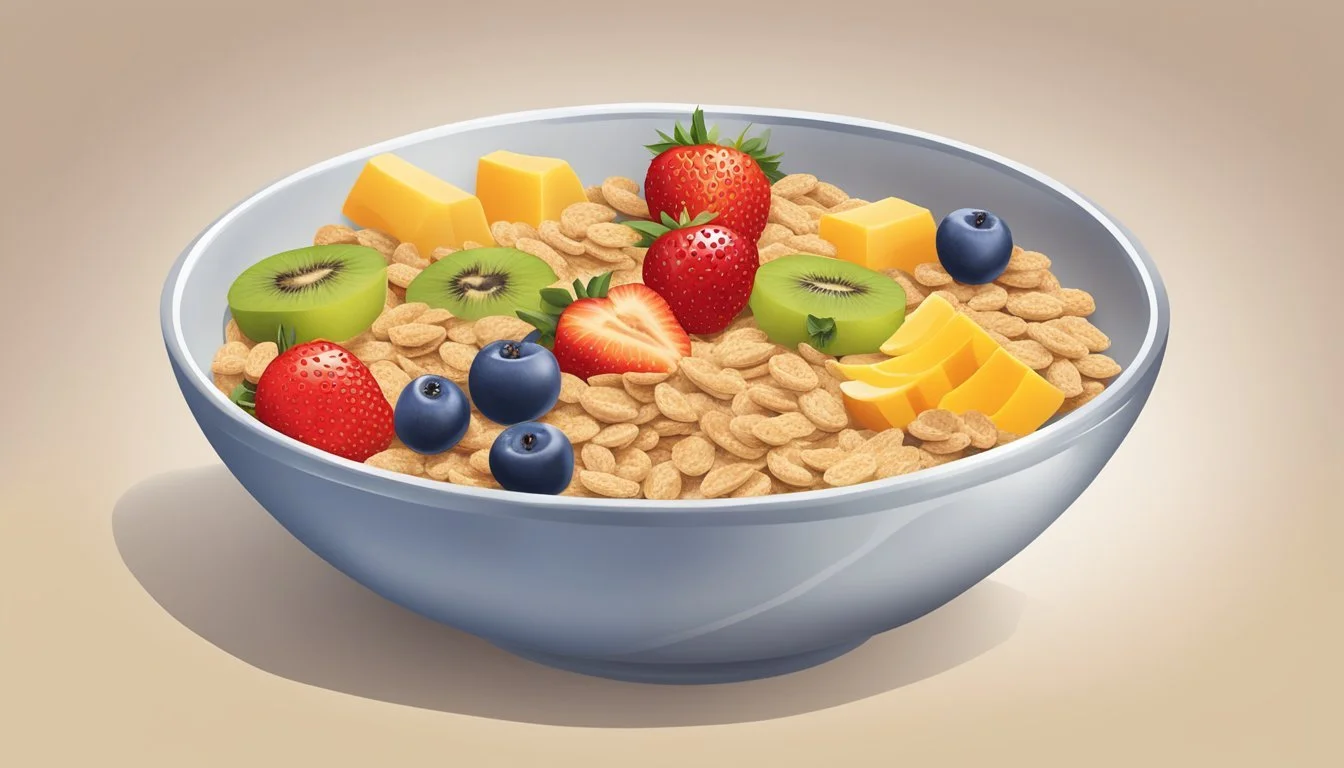Weetabix Nutrition Facts & More
Essential Facts for a Balanced Breakfast
Weetabix, a popular breakfast cereal, offers a nutritious start to the day. Made from 95% whole grain wheat, it provides essential nutrients and fiber to support a healthy diet. Two Weetabix biscuits contain 136 calories, 12 grams of protein, and 10 grams of fiber, making it a filling and nutritious breakfast option.
This cereal is low in fat, sugar, and salt, aligning with recommendations for a balanced diet. Weetabix is also fortified with vitamins and minerals, contributing to daily nutrient intake. Its high fiber content aids digestion and promotes feelings of fullness, which may help with weight management.
Weetabix can be part of a varied and healthy eating plan. Its versatility allows for customization with milk, fruits, or nuts, adding flavor and additional nutrients. The cereal's simple ingredient list and nutritional profile make it a practical choice for those seeking a wholesome breakfast option.
What Is Weetabix?
Weetabix is a popular breakfast cereal made primarily from wholegrain wheat. It comes in the form of oval-shaped biscuits that are typically served with milk.
The cereal is known for its simple ingredients and nutritional value. Weetabix contains 95% wholegrain wheat, making it a fiber-rich option for breakfast.
Each serving of Weetabix (two biscuits) provides 136 calories. It is low in fat, sugar, and salt while being high in fiber and fortified with essential vitamins and minerals.
Weetabix offers various flavors beyond its original version, including chocolate and fruit options. This versatility allows consumers to enjoy different taste experiences while maintaining the cereal's core nutritional benefits.
The cereal has a low glycemic index, which means it doesn't cause rapid spikes in blood sugar levels. This characteristic makes Weetabix a suitable choice for those looking to maintain steady energy levels throughout the morning.
Weetabix can be eaten in multiple ways. While many prefer it soaked in milk, others enjoy it dry or with hot milk. It can also serve as a base for more elaborate breakfast creations by adding fruits, nuts, or yogurt.
Nutritional Profile
Weetabix offers a well-balanced nutritional profile with key macronutrients, vitamins, and minerals. It provides a low-fat, high-fiber breakfast option with a moderate calorie content per serving.
Macronutrients
Weetabix is primarily composed of carbohydrates, with a focus on whole grains. A standard two-biscuit serving contains:
26g of carbohydrates
4g of protein
0.8g of total fat
3.8g of fiber
The cereal is low in sugar, with only 1.6g per serving. This makes it a suitable choice for those monitoring their sugar intake. The high fiber content promotes digestive health and helps maintain feelings of fullness.
Vitamins and Minerals
Weetabix is fortified with essential vitamins and minerals:
Iron: 25% of daily value
Riboflavin (B2): 25% of daily value
Thiamin (B1): 25% of daily value
Niacin: 25% of daily value
Folic Acid: 25% of daily value
It also contains calcium, vitamin D, vitamin B6, and vitamin B12 in smaller amounts. These nutrients support various bodily functions, including energy metabolism and bone health.
Calories and Serving Size
A standard serving of Weetabix consists of two biscuits, weighing approximately 37.5g. This serving contains:
136 calories
26g of carbohydrates
4g of protein
0.8g of fat
The relatively low calorie content makes Weetabix a good option for weight management. The serving size is easily customizable, allowing individuals to adjust their intake based on personal nutritional needs.
Health Benefits
Weetabix offers several health advantages due to its nutrient profile and wholesome ingredients. This cereal provides essential vitamins, minerals, and fiber that contribute to overall well-being.
Digestive Health
Weetabix is high in fiber, promoting digestive health and regularity. The wholegrain content supports a healthy gut microbiome. Each serving contains about 3.8 grams of fiber, contributing to the recommended daily intake.
Fiber aids in preventing constipation and maintaining bowel health. It also helps control blood sugar levels by slowing digestion, which can be beneficial for managing diabetes.
The insoluble fiber in Weetabix adds bulk to stool, easing passage through the digestive tract. This can help reduce the risk of hemorrhoids and diverticular disease.
Weight Management
Weetabix can be a helpful addition to weight management diets. Its high fiber content promotes feelings of fullness, potentially reducing overall calorie intake.
With only 136 calories per two-biscuit serving, Weetabix is a low-calorie breakfast option. It's also low in fat, containing just 0.8 grams per serving.
The wholegrain in Weetabix provides complex carbohydrates, which release energy slowly. This steady energy release helps maintain satiety and prevents sudden hunger spikes.
Weetabix's low sugar content (1.6 grams per serving) makes it a smart choice for those watching their sugar intake.
Energy and Vitality
Weetabix contains essential B vitamins, including thiamin, riboflavin, niacin, and folate. These vitamins play crucial roles in energy metabolism, helping convert food into usable energy.
Iron in Weetabix supports red blood cell production, helping to prevent anemia and reduce tiredness and fatigue. One serving provides about 15% of the daily recommended iron intake.
The complex carbohydrates in Weetabix provide sustained energy throughout the morning, making it an excellent breakfast choice for maintaining vitality.
Fortified with additional vitamins and minerals, Weetabix contributes to overall nutritional intake and supports a healthy immune system.
Reduced Disease Risk
Regular consumption of wholegrains, like those found in Weetabix, is associated with a reduced risk of heart disease. The fiber content helps lower cholesterol levels and maintain healthy blood pressure.
The low fat and sugar content of Weetabix aligns with dietary recommendations for heart health. It's particularly low in saturated fat, containing only 0.2 grams per serving.
Wholegrains in Weetabix may help reduce the risk of type 2 diabetes by improving insulin sensitivity and blood sugar control.
The antioxidants present in wholegrains can contribute to overall health by protecting cells from oxidative stress and inflammation.
Dietary Considerations
Weetabix offers options for various dietary needs, but some consumers may need to consider allergens and specific nutritional requirements.
Allergens and Sensitivities
Weetabix contains wheat, which is a common allergen. Individuals with celiac disease or gluten sensitivity should avoid this cereal. The product may also be processed in facilities that handle other allergens like nuts or milk.
Manufacturers typically provide clear allergy advice on packaging. Consumers with food allergies should carefully review ingredient lists and manufacturing information before consuming Weetabix or any cereal products.
Special Diets
Weetabix can fit into many dietary patterns. It is low in fat and sugar, making it suitable for those watching their intake of these nutrients. The cereal is high in fiber, which can support digestive health and weight management goals.
Vegans can enjoy Weetabix as it contains no animal-derived ingredients. However, those following strict gluten-free diets must avoid it due to its wheat content. For individuals on low-calorie diets, Weetabix provides a measured portion size with known caloric value.
The cereal's fortification with vitamins and minerals can help meet daily nutrient needs, especially for those with restricted diets.
Incorporating Weetabix Into Your Diet
Weetabix offers versatility and nutritional benefits as a breakfast staple. Its mild flavor pairs well with various toppings and mix-ins, allowing for endless customization.
Breakfast Ideas
Start your day with two Weetabix biscuits and 125ml of cold skimmed milk for a balanced meal. Add fresh berries or sliced bananas for natural sweetness and extra vitamins.
For a protein boost, top with a dollop of Greek yogurt and a sprinkle of nuts. Drizzle honey or add a dash of cinnamon for flavor without excess calories.
Try warming the milk before pouring it over Weetabix for a comforting hot cereal option. This method works well in colder months.
For a chocolatey treat, crumble one Weetabix biscuit over low-fat chocolate pudding. This satisfies sweet cravings while providing fiber and nutrients.
Recipes and Alternatives
Blend Weetabix into smoothies for added fiber and texture. Combine with frozen fruit, yogurt, and milk for a quick breakfast or post-workout snack.
Use crushed Weetabix as a healthier alternative to breadcrumbs in recipes. It works well for coating chicken or fish before baking.
Create a parfait by layering crumbled Weetabix with yogurt and fruit in a glass. This makes an appealing breakfast or dessert option.
For a twist on traditional oatmeal, mix crushed Weetabix with hot milk and your favorite oatmeal toppings. This provides a unique texture and flavor combination.
Purchase and Storage
Weetabix is widely available in many countries. Proper storage ensures the cereal maintains its quality and nutritional value.
Where to Buy
Weetabix can be found in most major supermarkets and grocery stores. Large retailers like Tesco, Sainsbury's, Asda, and Morrisons in the UK stock Weetabix. In Ireland, SuperValu and Dunnes Stores are common stockists.
Many independent stores and local shops also carry Weetabix. Online retailers such as Amazon offer the cereal for convenient home delivery. Some health food stores stock Weetabix as well.
Weetabix is typically located in the breakfast cereal aisle. It's often sold in various pack sizes, from small boxes to larger family packs.
Storing Weetabix
Proper storage is key to maintaining Weetabix's crisp texture and nutritional quality. The cereal should be kept in a cool, dry place away from direct sunlight.
Once opened, transfer the biscuits to an airtight container to prevent moisture absorption. This helps maintain crispness and freshness. Alternatively, tightly seal the original packaging.
Weetabix typically has a long shelf life when stored correctly. Check the "best before" date on the packaging for guidance. The cereal is usually best consumed within 3-6 months of opening.
Avoid storing Weetabix in the refrigerator, as the moisture can make the biscuits soggy. Keep the cereal away from strong-smelling foods to prevent odor absorption.
Comparing Weetabix to Other Cereals
Weetabix offers a unique nutritional profile compared to other breakfast cereals. Its whole grain composition and minimal added ingredients set it apart in terms of health benefits and macronutrient balance.
Weetabix vs. Other Whole Grain Cereals
Weetabix competes with cereals like Shredded Wheat and Wheaties in the whole grain category. These cereals share similarities in their use of whole wheat as a primary ingredient.
Weetabix contains 136 calories per two-biscuit serving, making it a relatively low-calorie option. In comparison, Shredded Wheat typically has around 160-170 calories per serving, while Wheaties contains about 100 calories per cup.
Fiber content is a key differentiator. Weetabix provides a good amount of dietary fiber, though exact amounts vary by product. Shredded Wheat often leads in this category, with some varieties offering up to 6 grams of fiber per serving.
Nutritional Differences
Weetabix stands out for its low sugar content, with only 2.4 grams per serving. This is significantly less than many popular cereals, including sugar-frosted cornflakes and other sweetened options.
Nutrient Weetabix (2 biscuits) Sugar-frosted Cornflakes (typical serving) Calories 136 150-180 Sugar 2.4g 10-15g Fat 0.8g 0.5-1g
Weetabix is low in fat, with just 0.8 grams per serving, including minimal saturated fat and no trans fat. It's also cholesterol-free, making it heart-healthy.
The cereal provides a balanced mix of carbohydrates, with a focus on complex carbs from whole grains. This composition helps provide sustained energy throughout the morning.
Label Understanding and Daily Intake
Nutrition labels provide essential information about the nutrient content of foods. Understanding these labels and recommended daily intakes helps consumers make informed choices about their diet and overall health.
Reading Nutrition Labels
Nutrition labels display key information about a food's energy and nutrient content. The "Nutrition Facts" panel typically shows serving size, calories, and amounts of total fat, saturated fat, cholesterol, sodium, total carbohydrate, dietary fibre, sugars, protein, and various vitamins and minerals.
The "% Daily Value" (%DV) indicates how much a nutrient in a serving contributes to the recommended daily intake. A %DV of 5% or less is considered low, while 15% or more is high.
For Weetabix, a typical serving (2 biscuits) contains:
Calories: 136
Total Fat: 0.9g
Sodium: 102mg
Total Carbohydrate: 25g
Dietary Fibre: 3.8g
Recommended Daily Intake
The Reference Intake (RI) or Recommended Daily Intake (RDI) guides consumers on the amount of energy and nutrients they should consume daily for a balanced diet. These values are based on an average adult's needs.
General RDI guidelines for key nutrients:
Total Fat: 70g
Saturated Fat: 20g
Carbohydrates: 260g
Sugars: 90g
Protein: 50g
Fibre: 30g
Sodium: 2.4g
It's important to note that individual needs may vary based on factors such as age, gender, weight, and activity level. Consulting a healthcare professional can provide personalized nutrition advice.
Environmental and Ethical Considerations
Weetabix has taken steps to address environmental and sustainability concerns in its production processes. The company has implemented a sustainability program focused on reducing its environmental impact.
Key areas of focus include optimizing energy use, minimizing waste, and sourcing ingredients responsibly. Weetabix aims to use locally grown wheat when possible to reduce transportation emissions.
The company has also worked to improve its packaging sustainability. Efforts have been made to increase recyclability and reduce overall packaging materials used.
From an ethical standpoint, Weetabix provides employment opportunities in local communities where its facilities are located. Many employees have multi-generational connections to the company.
Choosing Weetabix as part of a healthy diet can align with sustainable eating practices. Plant-based foods like whole grain cereals generally have a lower environmental footprint compared to animal-based products.
Consumers interested in ethical eating may consider Weetabix's corporate responsibility initiatives when making purchasing decisions. The company has outlined commitments related to gender equality in its workforce.
Incorporating Weetabix into a balanced lifestyle can support both personal health and broader sustainability goals. Its whole grain ingredients provide nutritional benefits while its production aims to minimize negative environmental impacts.








